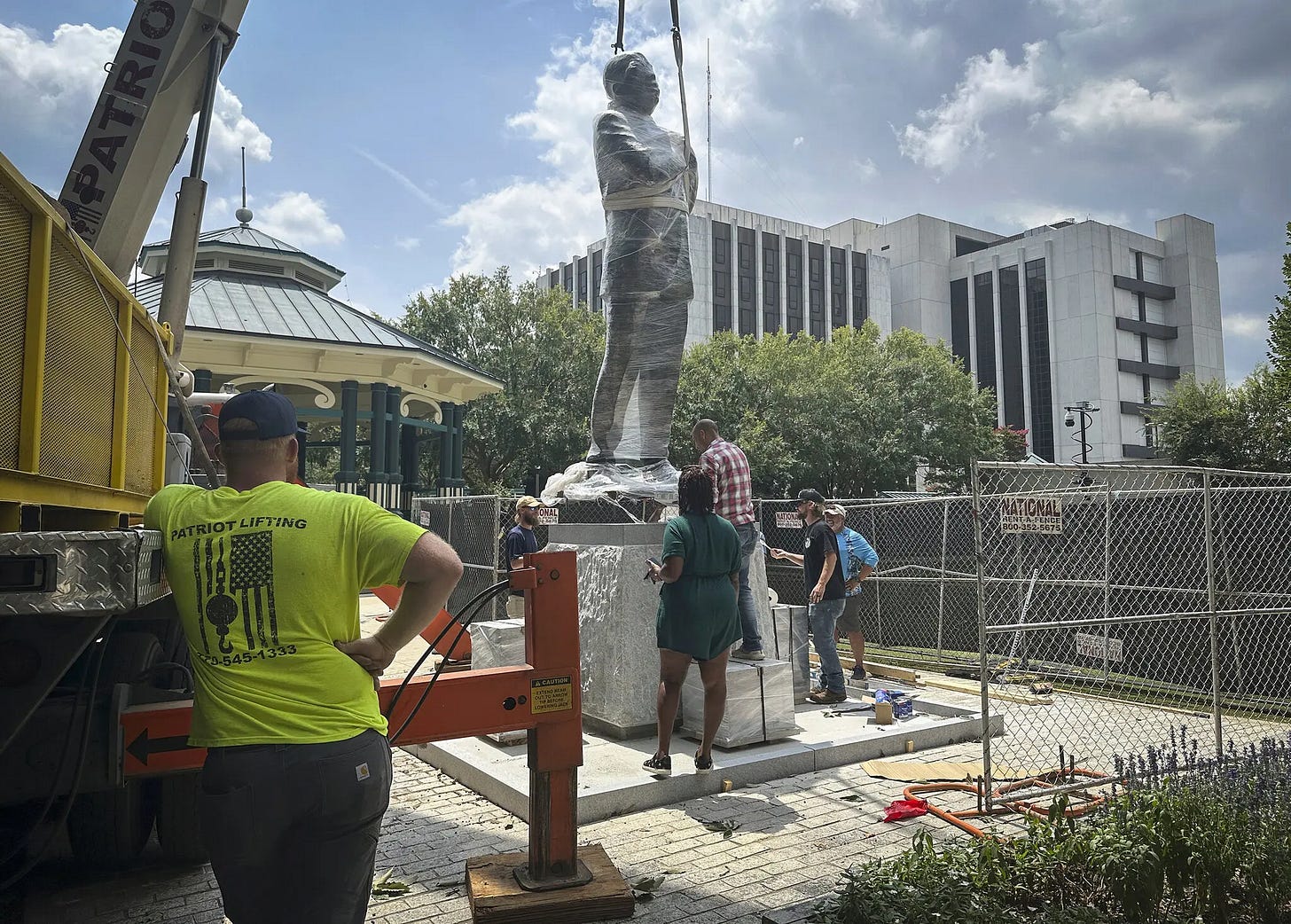John Lewis Monument Replaces A Monument to the Confederacy
...it's nice to read something positive
This showed up today in the NY Times. And since we seem to be on a monument kick, and since I’m in Northern California on my second wildland fire of the season - the Boise Fire - and since it’s a struggle to find the time to manage the medical component of the fire and keep up with The Civil Conversations Project and sleep - I thought I’d share this with you. And hey, at least it’s not a continuation of the sad Dred Scott/Roger Taney story.
A statue of John Lewis, the civil rights leader and congressman, was installed on Friday in front of a Georgia county courthouse in a space occupied for more than 100 years by a Confederate memorial.
The 12-foot-tall bronze statue was placed in front of the DeKalb County Courthouse in Decatur, Ga., which was part of the congressional district that Mr. Lewis represented for 17 consecutive terms.
A statue of John Lewis, the civil rights leader, outside the DeKalb County Courthouse. It will officially be unveiled on Aug. 24.Ron Harris/Associated Press
For years, activists pushed for the Confederate memorial, a 30-foot stone obelisk that had stood in the same spot as the new statue, to be removed. In 2019, a plaque was installed that said the memorial promoted white supremacy and the obelisk was removed in 2020.
Before Mr. Lewis, a Democrat, was elected to Congress, he had risked his life for the civil rights movement. He was one of the original 13 Freedom Riders who rode buses across the South in 1961 to protest segregation on public transportation and was a founder of the Student Nonviolent Coordinating Committee, which coordinated sit-ins.
He helped organize the March on Washington and helped lead hundreds of demonstrators across the Edmund Pettus Bridge in Selma, Ala., in 1965 to demand voting rights. At the march in Selma, a trooper fractured Mr. Lewis’s skull with a club after troopers attacked the nonviolent demonstrators.
The statue of Mr. Lewis, sculpted by the artist Basil Barrington Watson, who was born in Kingston, Jamaica, and moved to Georgia in 2002, will officially be unveiled on Aug. 24.
The sculpture stands where a Confederate monument was placed in 1908 by the United Daughters of the Confederacy. (More on this powerful but harmful group soon) The organization was behind the creation of Confederate memorials and monuments and played a key role in promoting the Lost Cause narrative of the Civil War, which downplays or ignores the role of slavery as the war’s cause.
The obelisk was one of at least 230 Confederate symbols to be removed, relocated or renamed after George Floyd, a Black man, was killed by a white police officer in Minneapolis in 2020.
Amid calls to take down the obelisk in Decatur, a DeKalb County judge said in June 2020 that it was a public nuisance and should be removed and put in storage.
Local groups had previously urged for the memorial to be removed, including in 2017 after a woman was killed protesting a white nationalist rally in Charlottesville, Va., but officials said that state law blocked them from taking it down.
In 2019, the DeKalb County Board of Commissioners installed a plaque near the monument that provided context for the memorial and said it had “bolstered white supremacy and faulty history.”
“This monument and similar ones also were created to intimidate African-Americans and limit their full participation in the social and political life of their communities,” the plaque read in part.
After Mr. Lewis died of pancreatic cancer in July 2020, a task force convened in Georgia to determine how to honor him.
Several groups suggested that a statue of Mr. Lewis be erected where the Confederate obelisk had stood and the task force agreed. The county commissioners unanimously approved the plan in January 2021 and the search began for an artist.
Tributes to Mr. Lewis were made across the country after he died, including at a Virginia high school, which had been named after the Confederate general, Robert E. Lee, and is now named the John R. Lewis High School.
And on the personal side, I was 16 when John Lewis strode across the Pettus bridge to get clubbed and suffer a split skull by the Alabama State Police, and 12 when Freedom Riders – Black and White - boarded buses in the Washington DC and rode them into the deep south in order to challenge the non-enforcement of the United States Supreme Court decision Morgan versus Virginia in 1946 and Boyton versus Virginia in 1960 which had ruled that segregated public buses were unconstitutional. The southern states had ignored the rulings and the federal government did nothing to enforce them. In order to participate, riders had to acknowledge that they may suffer great bodily harm and death. They did indeed suffer.
Being 12 and 16, I never had to even consider participating. But as an adult, I have often wondered if I would have had the extreme courage to participate. I’ll never know.







I had the honor of meeting the Honorable John Lewis a number of times connected with museum work, the Presidential Commission for the Creation of a National African American Museum, and visits to his office with both of my kids at separate times.
He was a short man, but an absolute towering giant in terms of honor, commitment and vision. A Gentleman's Gentleman. Warm, open, funny, and as my Dad would have said, "Right Down Front."
May his memory be a blessing to all who knew him and to the nation that he was dedicated to saving.